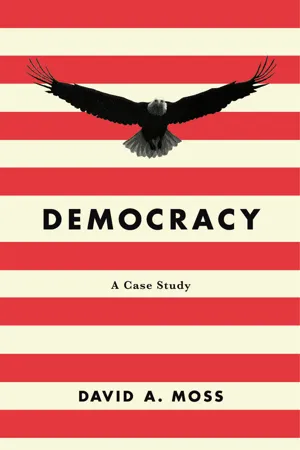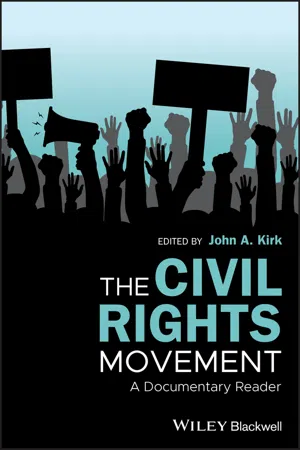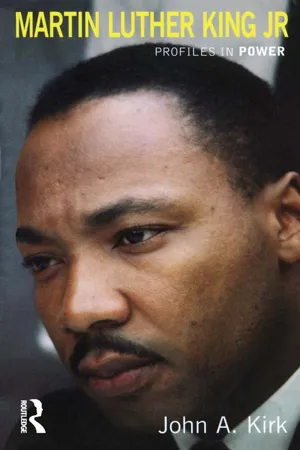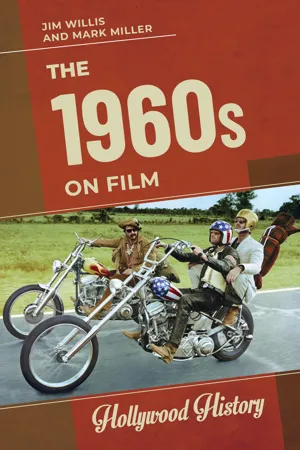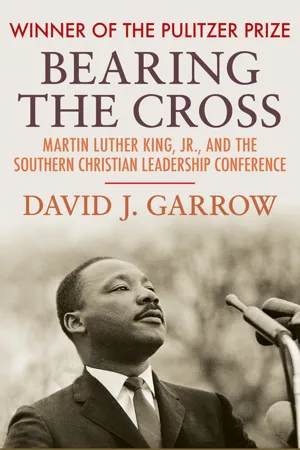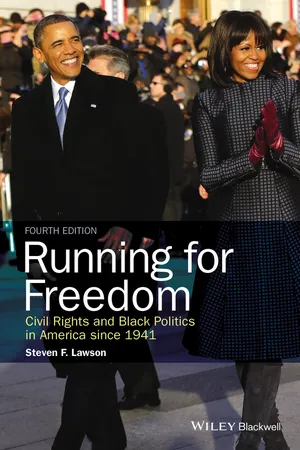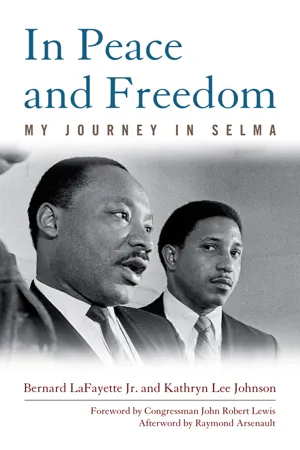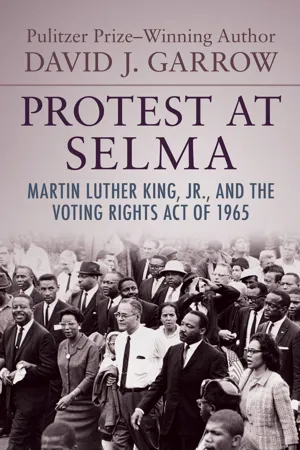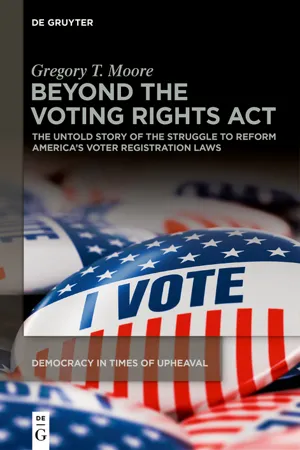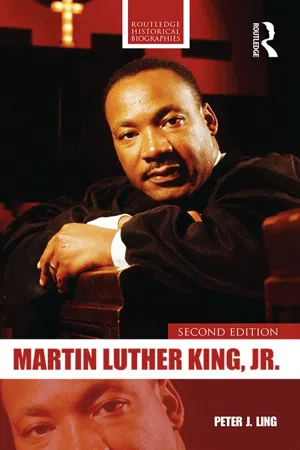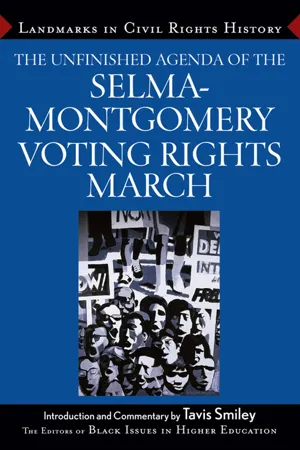History
March to Selma
The March to Selma refers to the series of civil rights marches from Selma to Montgomery, Alabama in 1965. Led by activists including Martin Luther King Jr., the marches aimed to protest racial discrimination in voting rights and to demand equal access to the ballot box for African Americans. The marches ultimately led to the passage of the Voting Rights Act of 1965.
Written by Perlego with AI-assistance
Related key terms
11 Key excerpts on "March to Selma"
- eBook - ePub
- David A. Moss(Author)
- 2017(Publication Date)
- Belknap Press(Publisher)
.{16} .Martin Luther King and the Struggle for Black Voting Rights (1965) a
ON TUESDAY AFTERNOON, March 9, 1965, Martin Luther King Jr. led more than 2,000 protestors—blacks and whites, men in jackets and ties, women in dresses—on a march from Brown Chapel, an African Methodist Episcopal church in Selma, Alabama, to the Edmund Pettus Bridge, spanning the Alabama River, a short distance away. He faced an agonizing decision about whether to defy a federal court order by crossing the bridge.1The 36-year-old Baptist minister and director of the Southern Christian Leadership Conference (SCLC) had recently won the Nobel Peace Prize for his leadership of the civil rights movement in the United States. The movement aimed to overturn state laws and customs requiring racial segregation in the South, as well as state laws and practices that disenfranchised black voters there. King had helped launch the movement in 1955 as the spokesman for a boycott against segregated buses in Montgomery, the state capital of Alabama, and had brought the segregation issue unprecedented attention with a campaign of mass nonviolent civil disobedience in Birmingham, Alabama, in 1963. In the summer of 1964 Congress had enacted a sweeping Civil Rights Act, largely banning legally enforced segregation. Yet suppression of black voters remained pervasive across the South, leading King to take the SCLC to Selma in January 1965 to start a campaign for voting rights.Central to the campaign was a series of illegal but nonviolent protest marches. In February one of these marches had been broken up by white rioters, local lawmen (including Sheriff Jim Clark), and state troopers, one of whom had shot and killed a marcher, Jimmie Lee Jackson. In response, the SCLC had announced a three-day protest march from Brown Chapel, their Selma headquarters, to the Alabama state capitol building in Montgomery, more than fifty miles away down Highway 80. The governor, George Wallace, who had risen to national fame as an opponent of the civil rights movement, banned the march. The leaders of the SCLC decided to defy his order, expecting that marchers would be arrested at the Pettus Bridge, which connected downtown Selma to the highway. - eBook - ePub
The Civil Rights Movement
A Documentary Reader
- John A. Kirk, John A. Kirk(Authors)
- 2020(Publication Date)
- Wiley-Blackwell(Publisher)
SEC. 5. Whenever a State or political subdivision with respect to which the prohibitions set forth in section 4(a) are in effect shall enact or seek to administer any voting qualification or prerequisite to voting, or standard, practice, or procedure with respect to voting different from that in force or effect on November 1, 1964, such State or subdivision may institute an action in the United States District Court for the District of Columbia for a declaratory judgment that such qualification, prerequisite, standard, practice, or procedure does not have the purpose and will not have the effect of denying or abridging the right to vote on account of race or color, and unless and until the court enters such judgment no person shall be denied the right to vote for failure to comply with such qualification, prerequisite, standard, practice, or procedure: Provided, That such qualification, prerequisite, standard, practice, or procedure may be enforced without such proceeding if the qualification, prerequisite, standard, practice, or procedure has been submitted by the chief legal officer or other appropriate official of such State or subdivision to the Attorney General and the Attorney General has not interposed an objection within sixty days after such submission, except that neither the Attorney General’s failure to object nor a declaratory judgment entered under this section shall bar a subsequent action to enjoin enforcement of such qualification, prerequisite, standard, practice, or procedure. Any action under this section shall be heard and determined by a court of three judges in accordance with the provisions of section 2284 of title 28 of the United States Code and any appeal shall lie to the Supreme Court.Approved August 6, 1965.Source: US Congress, Voting Rights Act of 1965, http://www.ourdocuments.gov/doc.php?doc=100&page=transcriptDiscussion Questions
- What does the Selma campaign tell us about the advantages and disadvantages of Martin Luther King, Jr’s prominent national profile in the civil rights movement?
- Why did King choose to defy a federal court order to hold a second march from Selma to Montgomery? Was he right to do so?
- Assess the significance of President Lyndon B. Johnson’s use of the movement’s refrain “We Shall Overcome” in his remarks to Congress.
Further Reading
- Combs, Barbara Harris. From Selma to Montgomery: The Long March to Freedom(Routledge, 2014).
- Ellis, Sylvia. Freedom’s Pragmatist: Lyndon Johnson and Civil Rights(University Press of Florida, 2013).
- Garrow, David J. Protest at Selma: Martin Luther King, Jr, and the Voting Rights Act of 1965(Yale University Press, 1978).
- Garrow, David J. The FBI and Martin Luther King, Jr: From “Solo” to Memphis(W.W. Norton, 1981).
- Lawson, Steven F. Black Ballots: Voting Rights in the South, 1944–1969(Columbia University Press, 1976).
- May, Gary. Bending toward Justice: The Voting Rights Act and the Transformation of American Democracy(Basic Books, 2013).
- O’Reilly, Kenneth. Racial Matters: The FBI’s Secret File on Black America, 1960–1972(Free Press, 1989).
- Stanton, Mary. From Selma to Sorrow: The Life and Death of Viola Liuzzo(University of Georgia Press, 1998).
- Thornton, J. Mills. Dividing Lines: Municipal Politics and the Struggle for Civil Rights in Montgomery, Birmingham, and Selma(University of Alabama Press, 2002).
- Webb, Sheyann, and Rachel West Nelson. Selma, Lord, Selma: Girlhood Memories of the Civil Rights Days
- eBook - ePub
- John A. Kirk(Author)
- 2014(Publication Date)
- Routledge(Publisher)
Chapter 5 ___________________A Movement in Transition, 1965–6
King and the SCLC’s 1965 Selma campaign marked the culmination of its southern-based Birmingham strategy, which it had developed since 1963. Working alongside SNCC and local people, King and the SCLC ran nonviolent, direct-action demonstrations that led to confrontation and conflict with Alabama state troopers. The violence used against the demonstrations prompted federal intervention in the form of troops on the ground and federal legislation with the introduction of the voting rights bill to Congress, which was later passed as the 1965 Voting Rights Act. The Selma campaign brought more public sympathy, support from northern whites and action from the federal government than any other event in the civil rights movement.Yet Selma gave way to a period of transition that signalled the drawing to a close of one phase of the civil rights movement and the beginning of another. With two of the central demands of the movement met – the 1964 Civil Rights Act ending segregation in public facilities and accommodations, and the 1965 Voting Rights Act removing obstacles to black voting rights – King, the SCLC and others in the civil rights movement faced the question of what their future goals should be.As King and the SCLC reflected upon what to do next, it was developments elsewhere that shaped their response to that question. Just five days after President Johnson signed the 1965 Voting Rights Act, one of the worst race riots of the post-war era broke out in Watts, Los Angeles. There had been racial disturbances in several cities the year before and Watts presaged a number of riots that rocked urban areas, particularly in the west and north of the United States, over the following years. Partly as a result of the Watts riot, King and the SCLC launched their first northern-based campaign in Chicago, where they attempted to modify their Birmingham strategy to address the multitudinous problems of the northern black ghetto. While the Chicago campaign was under way, the slogan of ‘Black Power’ was popularised by new SNCC chair Stokely Carmichael on the James Meredith-inspired March Against Fear through Mississippi. The slogan quickly gained currency, particularly among militant black youth groups. The outbreak of urban rioting and the emergence of black power highlighted black constituencies that King and the SCLC, by hitherto concentrating on southern small towns and cities, had largely left ignored: the black urban poor and powerless in America’s major cities and the black rural poor and powerless in isolated southern communities. Both these groups felt increasingly neglected by the civil rights movement. Indeed, many of those people began openly to question if the goals and tactics of the civil rights movement as King and the SCLC articulated them were, in fact, relevant to them at all. - eBook - ePub
- Jim Willis, Mark Miller(Authors)
- 2021(Publication Date)
- ABC-CLIO(Publisher)
Chapter 9Selma (2014)The Edmund Pettus Bridge in south-central Alabama was stained by violence on one “Bloody Sunday” in March 1965. When 500-some unarmed Black citizens marched across the bridge on Route 80, chaos erupted as local police troopers met the peaceable demonstrators with a brutal onslaught. The victims of that day’s savage display of racism comprised a group of Black activists assembled under the leadership of Dr. Martin Luther King Jr. during a critical moment in the civil rights movement. The decisive campaign centered on the ability of African American citizens in Selma, Alabama, to secure equal voting rights, and the protest took on the form of a 54-mile march from Selma to Montgomery. The 2014 film Selma takes viewers back to the three months in which the action took place, following King (David Oyelowo) as well as his activist colleagues James Bevel (Common), Hosea Williams (Wendell Pierce), and John Lewis (Stephan James).Following his personal triumph on receiving the Nobel Peace Prize in Oslo, Norway, King returns to American soil to confront the trying circumstances that compel him to visit southern territory. After holding conversations with President Lyndon Johnson (Tom Wilkinson) that can only go so far, King resorts to the only strategy he knows will work: use nonviolent protests as a platform for social reform while intentionally eliciting racist backlash—all while the TV cameras are watching. Though they recognize the high likelihood of physical harm ahead of them, the tight-knit band of civil rights leaders consider the risk well worth taking, as the stakes are high with the entire nation increasingly embroiled in conflicts linked to racial discrimination. King’s fervor—and the nation backing him—would lead thousands to join the cause and march the road from Selma toward historic legislative action that same year. - eBook - ePub
Bearing the Cross
Martin Luther King, Jr., and the Southern Christian Leadership Conference
- David J. Garrow(Author)
- 2015(Publication Date)
- Open Road Media(Publisher)
“Selma was bigger than Birmingham, though it was smaller in scope, because for the first time whites and Negroes from all over the nation physically joined the struggle in a pilgrimage to the deep south. This was a new level of commitment because it entailed danger and continuity. But more important, the elements who responded were for the first time a true cross-section of America,” a much broader coalition of support for the movement than ever before. Such a development presented King with both opportunities and dangers, Levison counseled. “Selma and Montgomery made you one of the most powerful figures in the country — a leader now not merely of Negroes, but of millions of whites.” The civil rights movement was “one of the rare independent movements” America had seen, “and you are one of the exceptional figures who attained the heights of popular confidence and trust without having obligations to any political party or other dominant interests. Seldom has anyone in American history come up by this path, fully retaining his independence and freedom of action.” That position was all the more influential, Levison told King, because “the movement you lead is the single movement in the nation at this time which arouses the finer democratic instincts of the nation.” While “there is a sense of shame people feel over the rampant greed and materialism surrounding us,” and while “doubt and concern trouble millions about our actions in Viet Nam,” King and the movement are “the great moral force in the country today.… You symbolize courage, effectiveness, singleness of will, honesty and idealism. You are free of the taint of political ambition, wealth, power or the pursuit of vanity. Your image has more purity than any American has attained in decades.” Several factors complicated the situation, Levison warned. One was the dynamics of the Selma protests: Nonviolent direct action was proven by Selma to have even greater power than anyone had fully realized - eBook - ePub
Running for Freedom
Civil Rights and Black Politics in America since 1941
- Steven F. Lawson(Author)
- 2014(Publication Date)
- Wiley-Blackwell(Publisher)
4 Reenfranchisement and Racial ConsciousnessThe Selma Movement and the Voting Rights Act of 1965
The distance between Oslo, Norway, and Selma, Alabama, spanned more than an ocean and thousands of miles. For African Americans it represented the difference between dignity and degradation. The winner of the 1964 Nobel Peace Prize, Dr. Martin Luther King, Jr., returned to the United States after obtaining his prestigious award in Oslo and journeyed to Selma in hope of eliminating the gap between the honorific treatment he had received abroad and the lack of respect blacks were accorded at home. Specifically, he sought to do something about the continuing denial of their right to vote. Throughout the former Confederate states, approximately 57 percent of eligible blacks remained off the suffrage rolls; in Alabama, the figure was a more shocking 77 percent; and in Dallas County, where Selma was the county seat, only 335 blacks out of a total population of 15,000 were registered. With this in mind, on January 2, 1965, Dr. King told an audience gathered at Selma's Brown Chapel AME Church what was at stake in the demonstrations the SCLC was about to launch. “When we get the right to vote,” he predicted, “we will send to the statehouse not men who will stand in the doorways of universities to keep Negroes out, but men who will uphold the cause of justice.”King's plans capped the 20-year struggle to reenfranchise black southerners. Since the outlawing of the white primary in 1944, civil rights groups and the national government had attempted to remove discriminatory barriers impeding black suffrage. Though a combination of litigation, legislation, and voter registration campaigns had yielded much progress, the majority of southern blacks still were disfranchised and were likely to stay so unless state and local officials lost their stranglehold on the enrollment process. Like most of the gains made during the civil rights era, the expansion of black ballots depended upon the power of the federal government in reinforcing the efforts of blacks at the local level, who were already fighting for first-class citizenship. - eBook - ePub
In Peace and Freedom
My Journey in Selma
- Bernard LaFayetteJr., Kathryn Lee Johnson(Authors)
- 2013(Publication Date)
- The University Press of Kentucky(Publisher)
We wouldn’t carry the body of Jimmie Lee, but we would carry the weight of the movement and the grief of his family, and all would be empowered. The long march would give people a chance to think about the issues, to join in, and to prolong the pilgrimage. We planned for the march from Selma to Montgomery to begin in about two weeks following Jimmie Lee’s death. We thought that people could walk ten miles a day, so it would take five days, which I considered perfect to prolong the pilgrimage. This direct action was designed to mobilize the nation and to have a major impact in highlighting the issue of voting rights. We knew that many people in Selma could walk only for a couple of days, so it was necessary to feed the march from the outside and increase the numbers for more impact. We appealed to people to come from all parts of the country. It no longer was a local protest, but became a national movement. Several leaders were sent to cities all over the country to bring marchers down to Selma. I returned to Chicago to attend some meetings necessary for my job, but also to recruit people from that community to come south to support the Selma march. I planned to join them on the second day.When the first march was planned, Dr. King couldn’t be there on Sunday, the first day, but it was decided that the march should begin anyway and he would join it later. Dr. King and his father copastored the Ebenezer Baptist Church in Atlanta. They alternated preaching on the first Sunday of the month, the special Sunday when communion is celebrated. It was Dr. King’s turn, and he honored his commitment to his church. Rev. Ralph Abernathy, his movement colleague, was the pastor of West Hunter Baptist Church and also stayed in Atlanta to conduct his service. Rev. Abernathy was Dr. King’s closest friend; theirs was a lifelong friendship that began when they were both Baptist ministers in Montgomery during the 1955 bus boycott and cofounders of SCLC. He and Dr. King spent so much of their lives together, from planning campaigns, to being cellmates in jail, to being roommates in hotels, and their lives were so intertwined, that they were sometimes referred to as the “movement twins.” In private conversations Rev. Abernathy told me that he always thought their lives would end together. But fortunately, they didn’t. - eBook - ePub
Protest at Selma
Martin Luther King, Jr., and the Voting Rights Act of 1965
- David J. Garrow(Author)
- 2015(Publication Date)
- Open Road Media(Publisher)
King’s most notable orations. Calling the national response to Selma “a shining moment in the conscience of man,” King declared, “We are on the move now.… We are moving to the land of freedom.” Let us march on the ballot boxes, he urged, while reminding his listeners that there would still be “a season of suffering” in many hard-core Deep South areas. But eventually, King said, “a society at peace with itself, a society that can live with its conscience” would be achieved. “How long will it take?” he asked, beginning his peroration. “I come to say to you this afternoon however difficult the moment, however frustrating the hour, it will not be long, because truth pressed to earth will rise again. How long?” he continued. “Not long, because no lie can live forever. How long? Not long, because you still reap what you sow.” King closed with several more repetitions of that dialogue, ending with the words of “The Battle Hymn of the Republic.” The rally concluded, the great crowd began to disperse to make its way home, and a small group of black Alabamians who had been designated to deliver the marchers’ petition to Wallace, who had watched the gathering through his office blinds, were turned away by a staff member at the capitol door. 49 The SCLC staff had emphasized to the marchers and visitors that they must depart from Montgomery as quickly as possible, so as not to provide targets to racist whites who had been drawn to watch the procession, and who, it was assumed, hoped to vent their hatred upon whatever unwary participants they could later waylay. Part of the movement’s transportation plans involved carrying some marchers back to Selma, and on the way back to Montgomery following such a trip one SCLC volunteer driver, a Michigan housewife and mother of five, Mrs. Viola Gregg Liuzzo, was shot to death at about 8:00 P.M. by a carload of pursuing Klansmen who overtook her car on a deserted stretch of Highway 80 in Lowndes County - eBook - ePub
Beyond the Voting Rights Act
The Untold Story of the Struggle to Reform America's Voter Registration Laws
- Gregory T. Moore(Author)
- 2022(Publication Date)
- De Gruyter(Publisher)
6 Back to Selma: Taking It to the StreetsThe defeat of the NVRA made newspaper headlines all across the country. Articles and some editorial boards chastised the Senate for its failure to pass such a simple “electoral reform” bill. It would be one of the symbols of the “gridlock” that characterized a host of other issues. Increased public awareness of the issue created a new opportunity to build grassroots support for the bill.The 25th anniversary of the voting rights march from Selma to Montgomery was being planned by the Southern Christian Leadership Conference and voting rights activists Rose and State Senator Hank Sanders. The Southern Rainbow Education Project, a progressive Southern independent affiliate of the National Rainbow Coalition, led by Montgomery’s Dr. Gwen Patton, was angered over Senator Richard Shelby’s opposition to the motor voter bill. Patton urged Rev. Jackson and the coalition to attend the march and make passage of the motor voter bill one of its central issues. Senator Shelby had been one of only three Southern Democrats to oppose the bill. The others, as mentioned, were Ernest Hollings of South Carolina and David Pryor of Arkansas. Rainbow activists in Alabama and South Carolina made plans to support the re-enactment of the Selma to Montgomery march as part of its voter outreach efforts, which had been dormant since the 1988 campaign. We were eventually able to get the National Voter Registration Act incorporated as one of the issues of the march.A Coalition of Conscience meeting had been planned in Selma by Rev. Dr. Joe Lowery and Coretta Scott King. The last time the group met was at the conclusion of the 25th Anniversary March in August 1988. At the urging of Rev. Jackson, the group planned to conduct voter registration drives throughout the march. CEF designed and printed 1500 posters for marchers to carry. The poster had both Dr. King’s and Rev. Jackson’s images with the slogan: “Commemorate the 25th - eBook - ePub
- Peter Ling(Author)
- 2015(Publication Date)
- Routledge(Publisher)
Despite its urban successes, evident in the more economically diversified Upper South, the VEP mainly demonstrated how slowly the electoral balance of power in the rural Deep South would change without radical measures to overcome vehement white supremacist resistance. After two years of intensive work and several violent, unpunished deaths, activists had raised African American voter registration in Mississippi from below 5 to less than 7 percent in what was potentially a black-majority state. At a time when rapid social and economic change was fueling black out-migration, the electoral power that might demand political action to reduce the suffering of displaced black tenants and laborers was in danger of evaporating before it could be used. Within a year of the Selma campaign, liberal legislation, be it civil rights or anti-poverty measures, seemed inadequate for the revolution that King sensed was needed. Poverty, institutional racism, and disempowerment required the sustained mobilization of an army of the disadvantaged. The middle classes could never be as radical as “legions of the deprived” (Jackson 2007: 195, 203)For much of 1964, James Bevel had lobbied King to launch an Alabama campaign focused on the right to vote. The prospect of teaming up with his former SNCC colleague, Bernard LaFayette, attracted Bevel to Selma, and the notoriety of Dallas County Sheriff Jim Clark, which matched that of Birmingham’s Bull Connor, attracted SCLC more generally. So, too, did the fact that local registrars routinely rejected would-be African American voters, while enrolling whites of equal or less educational competence. Despite SNCC’s efforts since 1963, whites comprised 99 percent of Selma’s voters, although they constituted less than half the adult population of the city’s 29,000 residents.Local efforts to implement desegregation under the new Civil Rights Act in July 1964 prompted State Judge James Hare to ban all gatherings of three or more under the auspices of SNCC, SCLC, the Dallas County Voters League (DCVL), or any one of more than forty named persons and organizations. But neither Hare’s blatant disregard for the First Amendment nor his open belief in white supremacy prevented this legal repression from staying in force for the rest of the year. According to an SCLC advance party, the only disadvantage to Selma as a site from which to dramatize the issue of voting rights was likely SNCC hostility. Two middle-class DCVL stalwarts, insurance agent Amelia Boynton and teacher Frederick Reese, reported that SNCC’s effort had “just about run its course” by late 1964. They appealed to SCLC to come and rejuvenate an enfeebled movement. But King knew that SNCC would not readily surrender its turf. It would demand consultation vociferously both before and during any protest campaign (Garrow 1988: 359-60). - (Author)
- 2007(Publication Date)
- Trade Paper Press(Publisher)
The LDF also played a pivotal role during the Selma campaign as the legal arm of the movement that helped to secure the sanction of the courts for the courageous activists. During the marches LDF attorneys represented more than 3,400 protesters. LDF filed and successfully argued the federal court case challenging Governor Wallace’s executive order forbidding the marches, and it represented Dr. King in related legal proceedings. Protesters and civil rights strategists led the charge, and the LDF provided a necessary complement to their efforts in the courtroom.The efforts of activists, lawyers, clergy, performers, the young and old, southerners and northerners, were interwoven. Each was critical in fomenting change but change—in the form of the Voting Rights Act— came when it did because no one was left to stand alone. The Selma campaign was not simply a way to express outrage over unfairness, though it was certainly that. The right to vote was, and is, too central a component of full citizenship for the protesters and their supporters to tolerate fruitless protest. Selma dramatically showed the way in which outrage could be effectively channeled to bring about change, and the lessons learned in Selma remain relevant today.Is the Struggle for Full Voting Rights Unfinished?
Unabashed racial discrimination does not exist to the extent that it did a generation ago, nor where it continues does it always take the same form as in earlier years. For example, in 1965 as a result of racial discrimination only 1 percent of African Americans was registered to vote in Dallas County (which includes Selma, Alabama). Now, with African American voters comprising nearly 60 percent of those registered in Dallas County, the citizens have twice elected James Perkins Jr., who in 2000 became Selma’s first African American mayor. The achievement is even more meaningful because Mr. Perkins won his office by defeating former segregationist Joseph Smitherman, the ten-term mayor who was serving at the time of the Bloody Sunday attack. These positive changes are significant but realism and honesty require that we consider the ways in which yesterday’s discrimination has mutated in some cases or become more subtle in others.
Learn about this page
Index pages curate the most relevant extracts from our library of academic textbooks. They’ve been created using an in-house natural language model (NLM), each adding context and meaning to key research topics.
